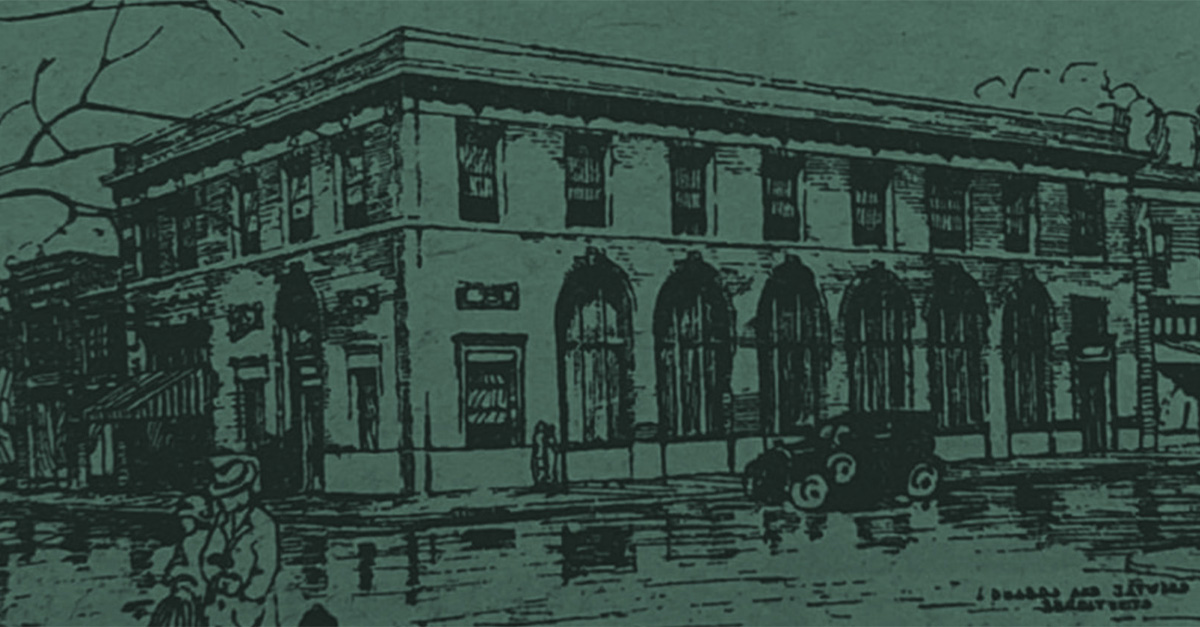For nearly 30 years, Lenz has called Downtown Decatur home, playing a dynamic role in the growth of a city that remains close to the company’s collective heart. It’s only fitting for Lenz to embark on its next chapter by moving into the 545 North McDonough Street building, a literal cornerstone of the Decatur Square, brimming with rich history.
That history dates back to the dawn of the Decatur Square. The town of Decatur, originally founded in 1823, began experiencing moderate growth in the mid- to late-1800s. It became the commercial center of DeKalb County with an array of businesses, both commercial and retail, primarily bunched around what is now Downtown Decatur Square.
The town incorporated as the City of Decatur in 1922, the same year the 545 North McDonough Street building was built in the heart of the Decatur Square, directly across from the original Courthouse. Designed by famed architect William Sayward, it reportedly cost $110,000 to build and was credited as Decatur’s first modern, fireproof structure. In 1924, it became home to the Decatur Bank and Trust Company. Georgia Tech students were consulted to test the bank’s steel vault door, which is still located in the basement today. The building’s large, rounded, architectural windows provided a bright perspective out onto the bustling Square. The bold, arched, original main entry, designed to mimic the shape of the windows, symbolized a journey toward a brighter tomorrow. It was a place where legendary professional golfer Bobby Jones deposited his winnings and the financial hopes and dreams of Decaturites seemed possible.
In 1925, the building served as the first home of the Decatur Library, which was the precursor to the DeKalb County Public Library. The Decatur Library was founded when a group of citizens, including Sayward’s wife Clara, formed the Decatur Library Association. The library later moved to City Hall where it stayed until a new building was built in 1950 on Sycamore Street.
By 1940, the Decatur Bank and Trust Company building found a new owner, the Decatur Building & Loan Association, which had been a ground-floor tenant for some time. Roxy’s Department Store was located in the remainder of the street level space, and offices occupied the upstairs.
Through the decades, 545 North McDonough Street housed an array of other tenants including additional financial institutions, lawyers, building contractors, opticians, dentists, residential appraisers, structural engineers, the Literacy Volunteers of America, and retailers. Its exterior has seen it all, witnessing the evolution of Decatur from the front row. While the Decatur Square thrived for decades – boasting its own movie theater, multiple department stores, and a grocery store – it began experiencing a downturn in the early 1970s as suburban malls and shopping centers drew business away.
The building stood firm during the foundation-rattling tunnelling and excavation project in the late 1970s that helped bring the MARTA rail system to life. Construction of MARTA’s East Line, including what would become the fully underground Decatur Station, broke ground in 1975, causing quite the disruption just steps from 545’s front door. Plans called for altering the 100 block of Sycamore Street in the Square that would be forever closed to vehicular traffic. During construction, pedestrian bridges were installed to allow access to businesses. A 1978 Atlanta Journal article reported that some businesses located on the Square had closed or were down as much as 66%, while others were less affected. On June 30, 1979, MARTA’s Decatur Station opened to the public, making it one of the first stops to be completed.
The Square’s resurgence slowly began to take place beginning in the late 1980s and into the ’90s, including with the opening in 1991 of Eddie’s Attic, a nationally recognized “listening room” that has served as homebase for world class musicians like the Indigo Girls, John Mayer, and Shawn Mullins. Decatur turned a substantial corner after a downtown beautification project was completed in time for the 1996 Olympic Games. In fact, the Olympic Torch was held high upon the steps of the Old Courthouse, directly across from the 545 McDonough Street building, on its way downtown to help kick off the festivities. Richard and John Lenz moved the business from Richard’s basement to the Decatur Square the following year and it remained there, at 119 East Court Square, for decades.
During the Olympics, Downtown Decatur served as home base for the Irish Olympic Team. The Square played host to its 14-day Hometown to the World Festival with a pop-up Irish bar, which would inspire the arrival of the famous Brick Store Pub a year later. This helped inject even more life back into the Decatur Square, which soon began luring more and more retailers, notable restaurants, and special events.
Lenz has lent a substantial hand to this growth by strongly supporting and publicizing local businesses, and creating, organizing, and promoting Decatur-based events. As for the latter, Lenz was instrumental in the development of the Decatur Book Festival, and founded and continues to operate the annual Amplify Decatur Music Festival, a high-profile, charitable weekend of live entertainment taking place on and around the Decatur Square.
As a resident of the Square, Lenz has a deep connection with its surroundings. After the removal of a longstanding Confederate monument in 2020, the 545 North McDonough Street building now proudly serves as neighbor to a statue honoring esteemed Civil Rights leader John Lewis.
Lenz moving into this storied space not only honors the past, but reflects our ongoing commitment to our employees, our clients, and the community we are honored to serve. As Decatur continues to grow, we’re honored to help shape its future from a place so deeply rooted in its narrative.

